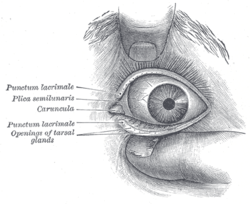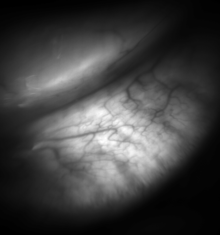Meibomian gland
Meibomian glands (often written with a small "m" and also called tarsal glands) are holocrine type exocrine glands, along the rims of the eyelid inside the tarsal plate. They produce meibum, an oily substance that prevents evaporation of the eye's tear film. Meibum prevents tears spilling onto the cheek, trapping the tears between the oiled edge and the eyeball, and making the closed lids airtight.[1] There are about 50 glands on the upper eyelid and 25 glands on the lower eyelid.
| Meibomian | |
|---|---|
 Front of left eye with eyelids separated to show medial canthus and openings of tarsal (meibomian) glands | |
| Identifiers | |
| MeSH | D008537 |
| TA | A15.2.07.042 |
| FMA | 71872 |
| Anatomical terminology | |
Dysfunctional meibomian glands often cause dry eyes, one of the more common eye conditions. They may also contribute to blepharitis.
The glands are named after Heinrich Meibom (1638–1700), a German physician, who first described them.[2][3]
Function
Meibum
Lipids
Lipids are the major components of meibum (also known as "meibomian gland secretions"). The term "meibum" was originally introduced by Nicolaides et al. in 1981.[4]
The biochemical composition of meibum is extremely complex and very different from that of sebum. Lipids are universally recognized as major components of human and animal meibum. Recently, an update on the composition of human meibum and on the structures of various positively identified meibomian lipids was published.[5]
Currently, the most sensitive and informative approach to lipidomic analysis of meibum is mass spectrometry either with direct infusion[6][7] or in combination with liquid chromatography.[8]
Proteins
In humans, more than 90 different proteins have been identified in meibomian gland secretions.[9]
Clinical significance

Dysfunctional meibomian glands often cause dry eyes, one of the more common eye conditions. They may also contribute to blepharitis. Inflammation of the meibomian glands (also known as meibomitis, meibomian gland dysfunction, or posterior blepharitis) causes the glands to be obstructed by thick waxy secretions. Besides leading to dry eyes, the obstructions can be degraded by bacterial lipases, resulting in the formation of free fatty acids, which irritate the eyes and sometimes cause punctate keratopathy.
Meibomian gland dysfunction is more often seen in women and is regarded as the main cause of dry eye disease.[10][11] Factors that contribute to meibomian gland dysfunction can include things such as a person's age and/or hormones[12] or severe infestation of Demodex brevis mite. Treatment can include warm compresses or expression of the gland by a professional. Lifitegrast and Restasis are topical medication commonly used to control the inflammation and improve the oil quality. In some cases topical steroids and topical/oral antibiotics are also prescribed reduce inflammation. Intense pulsed light (IPL) treatments have also been shown to reduce inflammation and improve the gland function in patients. Meibomian gland probing is also used on patients which experience deep clogging of the glands.
Meibomian gland dysfunction may be caused by some prescription medications, notably isotretinoin.
See also
- List of specialized glands within the human integumentary system
- Chalazion
References
- "eye, human." Encyclopædia Britannica. Encyclopædia Britannica Ultimate Reference Suite. Chicago: Encyclopædia Britannica, 2010.
- EyeWiki: Meibomian Gland Dysfunction (MGD): Disease
- Meibomii, Henrici (1666). De vasis palpebrarum novis epistola … [From a recent letter on the eyelids' vesicles to the most renowned gentleman Dr. Joel Langelott, court physician of the most reverend and serene Duke of Holstein] (in Latin). Helmstadt, (Germany): Henning Muller.
- Nicolaides, N; Kaitaranta, JK; Rawdah, TN; Macy, JI; Boswell, FM; Smith, RE (April 1981). "Meibomian gland studies: comparison of steer and human lipids". Invest Ophthalmol Vis Sci. 20 (4): 522–536. PMID 7194326.
- Butovich IA (November 2009). "The Meibomian puzzle: combining pieces together". Prog Retin Eye Res. 28 (6): 483–498. doi:10.1016/j.preteyeres.2009.07.002. PMC 2783885. PMID 19660571.
- Chen, J; Green-Church, K; Nichols, K (2010). "Shotgun lipidomic analysis of human meibomian gland secretions with electrospray ionization tandem mass spectrometry". Invest Ophthalmol Vis Sci. 51 (12): 6220–6231. doi:10.1167/iovs.10-5687. PMC 3055753. PMID 20671273.
- Chen, J; Nichols, K (2018). "Comprehensive shotgun lipidomics of human meibomian gland secretions using MS/MSall with successive switching between acquisition polarity modes". J Lipid Res. 59 (11): 2223–2236. doi:10.1194/jlr.D088138. PMC 6210907. PMID 30279222.
- Butovich, IA (2009). "Lipidomic analysis of human meibum using HPLC-MSn". Methods Mol Biol. 579: 221–246. doi:10.1194/jlr.D088138. PMID 19763478.
- Tsai, PS; Evans, JE; Green, KM; Sullivan, RM; Schaumberg, DA; Richards, SM; Dana, MR; Sullivan, DA (March 2006). "Proteomic analysis of human meibomian gland secretions". Br J Ophthalmol. 90 (3): 372–7. doi:10.1136/bjo.2005.080846. PMC 1856970. PMID 16488965.
- "Managing and Making Sense of MGD". Review of Ophthalmology. 2012. Retrieved 26 February 2014.
- "Rethinking Meibomian Gland Dysfunction: How to Spot It, Stage It and Treat It". American Academy of Ophthalmology. 2014. Retrieved 26 February 2014.
- "The Role of Meibomian Gland Dysfunction and Lid Wiper Epitheliopathy in Dry Eye Disease". American Academy of Optometry. 2012. Archived from the original on 9 October 2013. Retrieved 26 February 2014.